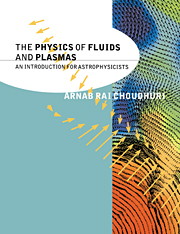Book contents
- Frontmatter
- Contents
- Preface
- Acknowledgements
- Introduction
- Part I Neutral fluids
- Part 2 Plasmas
- 10 Plasma orbit theory
- 11 Dynamics of many charged particles
- 12 Collisionless processes in plasmas
- 13 Collisional processes and the one-fluid model
- 14 Basic magnetohydrodynamics
- 15 Theory of magnetic topologies
- 16 Dynamo theory
- Epilogue
- Appendix A Useful vector relations
- Appendix B Integrals in kinetic theory
- Appendix C Formulae and equations in cylindrical and spherical coordinates
- Appendix D Values of various quantities
- Appendix E Basic parameters pertaining to plasmas
- Suggestions for further reading
- References
- Index
14 - Basic magnetohydrodynamics
from Part 2 - Plasmas
Published online by Cambridge University Press: 05 June 2012
- Frontmatter
- Contents
- Preface
- Acknowledgements
- Introduction
- Part I Neutral fluids
- Part 2 Plasmas
- 10 Plasma orbit theory
- 11 Dynamics of many charged particles
- 12 Collisionless processes in plasmas
- 13 Collisional processes and the one-fluid model
- 14 Basic magnetohydrodynamics
- 15 Theory of magnetic topologies
- 16 Dynamo theory
- Epilogue
- Appendix A Useful vector relations
- Appendix B Integrals in kinetic theory
- Appendix C Formulae and equations in cylindrical and spherical coordinates
- Appendix D Values of various quantities
- Appendix E Basic parameters pertaining to plasmas
- Suggestions for further reading
- References
- Index
Summary
The fundamental equations
We discussed in the previous chapter how the one-fluid or the MHD model of the plasma can be developed starting from microscopic considerations. It was not possible to give as thorough or as systematic a presentation of the subject as we did in Chapter 3, where the hydrodynamic model for neutral fluids was developed from the microscopic theory. We have not rigorously established the conditions under which the one-fluid model of a plasma holds. We saw in Chapter 3 that frequent collisions make a neutral gas behave like a continuous fluid. Collisions certainly help in establishing fluidlike behaviour. It was, however, mentioned in §11.7 that a strong magnetic field in a plasma can also keep charged particles confined within local regions for sufficient time, thereby giving rise to fluidlike behaviour even in the absence of collisions.
Between the microscopic model based on distribution functions and the macroscopic one-fluid model, there exists the intermediate twofluid model of the plasma discussed in Chapters 11–13. This was referred to in Table 1.1 as the 2½ level. When we consider phenomena in which electrons and ions respond differently (such as the propagation of electromagnetic waves through a plasma), the two-fluid model has to be applied rather than the MHD model. The MHD model is applicable only when charge separation is negligible. The condition for it is that the length scales should be larger than the Debye length and the time scales larger than the inverse of plasma frequency.
- Type
- Chapter
- Information
- The Physics of Fluids and PlasmasAn Introduction for Astrophysicists, pp. 276 - 318Publisher: Cambridge University PressPrint publication year: 1998



